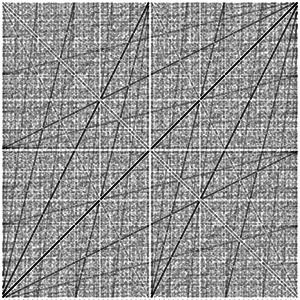 | ||
The dyadic transformation (also known as the dyadic map, bit shift map, 2x mod 1 map, Bernoulli map, doubling map or sawtooth map) is the mapping (i.e., recurrence relation)
Contents
- Relation to tent map and logistic map
- Periodicity and non periodicity
- Solvability
- Rate of information loss and sensitive dependence on initial conditions
- References
produced by the rule
Equivalently, the dyadic transformation can also be defined as the iterated function map of the piecewise linear function
The name bit shift map arises because, if the value of an iterate is written in binary notation, the next iterate is obtained by shifting the binary point one bit to the right, and if the bit to the left of the new binary point is a "one", replacing it with a zero.
The dyadic transformation provides an example of how a simple 1-dimensional map can give rise to chaos.
Relation to tent map and logistic map
The dyadic transformation is topologically conjugate to :
The r = 4 case of the logistic map is
There is semi-conjugacy between the dyadic transformation (here named angle doubling map) and the quadratic polynomial. Here map doubles angles measured in turns.
Periodicity and non-periodicity
Because of the simple nature of the dynamics when the iterates are viewed in binary notation, it is easy to categorize the dynamics based on the initial condition:
If the initial condition is irrational (as almost all points in the unit interval are), then the dynamics are non-periodic—this follows directly from the definition of an irrational number as one with a non-repeating binary expansion. This is the chaotic case.
If x0 is rational the image of x0 contains a finite number of distinct values within [0, 1) and the forward orbit of x0 is eventually periodic, with period equal to the period of the binary expansion of x0. Specifically, if the initial condition is a rational number with a finite binary expansion of k bits, then after k iterations the iterates reach the fixed point 0; if the initial condition is a rational number with a k-bit transient (k ≥ 0) followed by a q-bit sequence (q > 1) that repeats itself infinitely, then after k iterations the iterates reach a cycle of length q. Thus cycles of all lengths are possible.
For example, the forward orbit of 11/24 is:
which has reached a cycle of period 2. Within any sub-interval of [0,1), no matter how small, there are therefore an infinite number of points whose orbits are eventually periodic, and an infinite number of points whose orbits are never periodic. This sensitive dependence on initial conditions is a characteristic of chaotic maps.
Solvability
The dyadic transformation is an exactly solvable model in the theory of deterministic chaos. The square-integrable eigenfunctions of the associated transfer operator of the Bernoulli map are the Bernoulli polynomials. These eigenfunctions form a discrete spectrum with eigenvalues
Rate of information loss and sensitive dependence on initial conditions
One hallmark of chaotic dynamics is the loss of information as simulation occurs. If we start with information on the first s bits of the initial iterate, then after m simulated iterations (m < s) we only have (s − m) bits of information remaining. Thus we lose information at the exponential rate of one bit per iteration. After s iterations, our simulation has reached the fixed point zero, regardless of the true iterate values; thus we have suffered a complete loss of information. This illustrates sensitive dependence on initial conditions—the mapping from the truncated initial condition has deviated exponentially from the mapping from the true initial condition. And since our simulation has reached a fixed point, for almost all initial conditions it will not describe the dynamics in the qualitatively correct way as chaotic.
Equivalent to the concept of information loss is the concept of information gain. In practice some real-world process may generate a sequence of values {xn} over time, but we may only be able to observe these values in truncated form. Suppose for example that x0 = 0.1001101, but we only observe the truncated value 0.1001 . Our prediction for x1 is 0.001 . If we wait until the real-world process has generated the true x1 value 0.001101, we will be able to observe the truncated value 0.0011, which is more accurate than our predicted value 0.001. So we have received an information gain of one bit.
